| |
|
|
|
| |
|
Morocco:
West Atlas
Bicycle Africa / Ibike Tours |
|
| |
|
|
|
| |
 |
Western Atlas:
Volubilis |
|
| |
|
|
|
| |
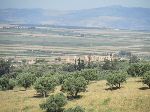
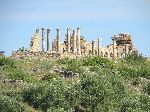 |
Three kilometers west of Moulay Idriss, and lower on the hill, are the
predominantly Roman ruins of Volubilis. It is still has high enough on a hill to
have a commanding view of
the fertile countryside. Volubilis is the ruins of an ancient Phoenician settlement and then Roman
town. It is the best preserved archeological site in Morocco. Volubilis was first developed from the 3rd century BC onwards
by the Phoenician (and later
Carthaginian). It grew and expanded rapidly under Roman rule from the 1st century
AD onwards. The city gained a
number of major public buildings in the 2nd century, including a basilica,
temple and triumphal arch. Its prosperity, which was derived principally from
olive growing, prompted the construction of many fine town-houses with large
mosaic floors. With the decline of the Roman empire, the local Berbers started to reassert
themselves. The Romans abandoned the city in about AD 280. A reduced settlement
of Volubilis continued to be inhabited until the 18th century, when the
buildings sustained heavy damage from the Lisbon earthquake of 1755, and then its marble was
plundered for the construction of Moulay Ismail's palace in Meknes30 km
east. |
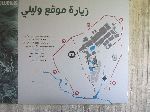 |
| |
|
|
|
| |
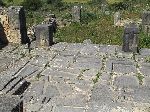 |
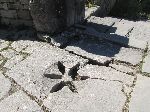 The excavated portion of the site has two sections, the southern section with
the major public buildings and the northern section which was primarily
residential and commercial. The excavated portion of the site has two sections, the southern section with
the major public buildings and the northern section which was primarily
residential and commercial.A lot of attention is paid to the grand
construction, but there are other details that are worthy of consideration; In
the paving of floors and laying of roads there are demonstrations of Roman
engineering and attention to good drainage systems, including decorative drain
covers (left). Another example of an interesting detail is a
public sundial (right).
|
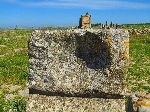 |
| |
|
|
|
| |
Gallienus Bath |
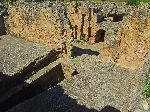 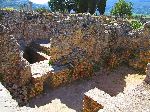 Typically
of a Roman town there were public baths. The Gallienus Bath is on the south side
of the public square. It was not the largest bath in town, but is the most
complex building at the site, today. Major baths have water systems, sewage
systems, cold rooms, warm rooms and hot rooms. All of this take some engineering
for both liquids, heating, and hot air. Typically
of a Roman town there were public baths. The Gallienus Bath is on the south side
of the public square. It was not the largest bath in town, but is the most
complex building at the site, today. Major baths have water systems, sewage
systems, cold rooms, warm rooms and hot rooms. All of this take some engineering
for both liquids, heating, and hot air. |
|
| |
|
|
|
| |
Olive press |
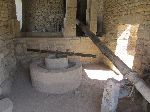 During
Roman times, Volubilis was a major producer of olive oil. The remains of
buildings dedicated to olive pressing are still readily visible, as are the
remains of the original presses and olive mills. One such building has been
reconstructed with a full-size replica of a Roman olive press. Olive oil was
central to the life of the city, as it was not just a foodstuff but was also
used for lamps, bathing, and medicines, while the pressed olives were fed to
animals or dried out and used as fuel for the bathhouses. For this reason, even
some of the grandest mansions had their own olive presses. Fifty-eight
oil-pressing complexes have so far been discovered in Volubilis. They housed a
standard set of elements: a mill, used to crush the olives, a decantation basin
to catch the oil from pressed olives, and a press that comprised a
counterweight, a prelum or cross-bar and the wooden supports within which
the prelum was fixed. The olives were first crushed into a paste, then
put into woven baskets that were subjected to pressing. The olive oil ran out
into the decantation basin, to which water was periodically added to make the
lighter oil float to the surface. This was then scooped out of the basin and
poured into amphorae. During
Roman times, Volubilis was a major producer of olive oil. The remains of
buildings dedicated to olive pressing are still readily visible, as are the
remains of the original presses and olive mills. One such building has been
reconstructed with a full-size replica of a Roman olive press. Olive oil was
central to the life of the city, as it was not just a foodstuff but was also
used for lamps, bathing, and medicines, while the pressed olives were fed to
animals or dried out and used as fuel for the bathhouses. For this reason, even
some of the grandest mansions had their own olive presses. Fifty-eight
oil-pressing complexes have so far been discovered in Volubilis. They housed a
standard set of elements: a mill, used to crush the olives, a decantation basin
to catch the oil from pressed olives, and a press that comprised a
counterweight, a prelum or cross-bar and the wooden supports within which
the prelum was fixed. The olives were first crushed into a paste, then
put into woven baskets that were subjected to pressing. The olive oil ran out
into the decantation basin, to which water was periodically added to make the
lighter oil float to the surface. This was then scooped out of the basin and
poured into amphorae. |
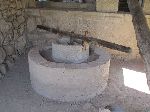
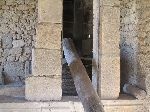 |
| |
|
|
|
| |
Capitoline Temple |
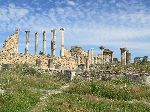 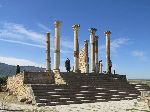 Overlooking
the Forum (public square / market) is the
Capitoline Temple. It is one of several temples that were around the Forum and
Basilica. It was constructed in about 218 AD, and dedicated to the Triad of Jupiter, Juno,
and Minerva. Overlooking
the Forum (public square / market) is the
Capitoline Temple. It is one of several temples that were around the Forum and
Basilica. It was constructed in about 218 AD, and dedicated to the Triad of Jupiter, Juno,
and Minerva. |
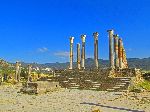 |
| |
|
|
|
| |
Basilica
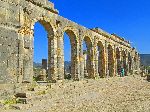 |
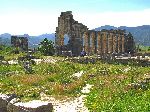 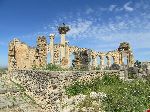 The
basilica (partially restored)
was used for the administration of justice and the governance of the city. It
was completed during the reign of Macrinus in the early 3rd century. It is
considered one of the finest Roman basilicas in Africa. The
reconstructed columns typically are occupied by stork nests. The storks are very
photogenic and are considered a good luck bird in North Africa. The
basilica (partially restored)
was used for the administration of justice and the governance of the city. It
was completed during the reign of Macrinus in the early 3rd century. It is
considered one of the finest Roman basilicas in Africa. The
reconstructed columns typically are occupied by stork nests. The storks are very
photogenic and are considered a good luck bird in North Africa. |
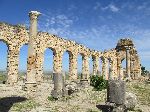 |
| |
|
|
|
| |
Arch of Caracalla |
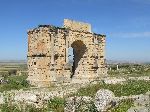 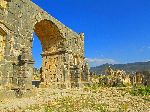 The
Arch of Caracalla (Triumphal arch), was built by the citizens of Volubilis to the
Roman Emperor Caracalla [Marcus Aurelius Severus Antoninus Augustus (4
April AD 188 – 8 April AD 217), Roman emperor (AD 198–217), son of Septimius
Severus] and his mother, Julia Domna, in thanks for not having to
pay taxes. Otherwise, Caracalla is remembered as one of the most notorious and
unpleasant of emperors. The
Arch of Caracalla (Triumphal arch), was built by the citizens of Volubilis to the
Roman Emperor Caracalla [Marcus Aurelius Severus Antoninus Augustus (4
April AD 188 – 8 April AD 217), Roman emperor (AD 198–217), son of Septimius
Severus] and his mother, Julia Domna, in thanks for not having to
pay taxes. Otherwise, Caracalla is remembered as one of the most notorious and
unpleasant of emperors. |
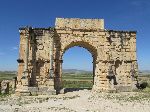 |
| |
|
|
|
| |
Decumanus Maximus |
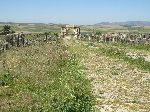
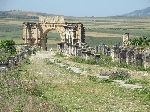
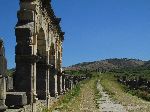
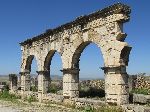 |
|
| |
|
Leading from the Arch of Caracalla to Tangiers Gate (north gate)
Decumanus Maximus (main street).
Decumanus Maximus is the widest street running through the town's residential
and retail area. When the town was prosperous it would have been lined with
storefronts. A section of it is demarked with a façade of arches for an arcade. |
|
| |
|
|
|
| |
Fountain and North Bath |
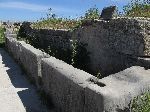 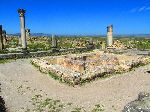 An
aqueduct runs from the hills and along Decumanus Secondary, which parallels
Decumanus Maximus, into the central crossroads of town. There, there is a public
fountain (left) and the North Bath (right). Located adjacent to a largely
residential area, in their day, the North Bath was the largest in town, but at
the zenith of Volubilis, the Gallienus Bath was the finest. An
aqueduct runs from the hills and along Decumanus Secondary, which parallels
Decumanus Maximus, into the central crossroads of town. There, there is a public
fountain (left) and the North Bath (right). Located adjacent to a largely
residential area, in their day, the North Bath was the largest in town, but at
the zenith of Volubilis, the Gallienus Bath was the finest. |
|
| |
|
|
|
| |
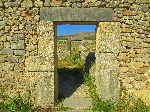 |
Archeologists estimated that at one time Volubilis had a population of 20,000.
Not enough housing stock has been excavated at this point to accommodate that
many people, especially considering that many of the residences that have been
exposed up to this point are spacious villas that probably had a relatively low
density of people living in them.
The abodes that have been excavated have been given names like House of Orpheus, House of the Euphebus, and
House of Dionysus, which have no historical significance, but reflect something
that the archeologist found at the site (i.e. a piece of art, a unique mosaic,
artifact, etc.). Some locations have multiple names, which might be the results
of variations in translation. |
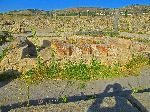 |
| |
House of Orpheus: |
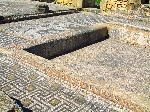
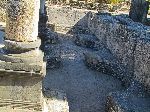
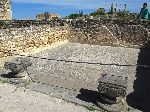
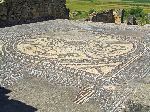 |
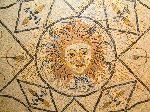 |
| |
|
The House of Orpheus is at the south end of the site, separated from the
other large villas that have been excavated. There a couple of basins or pools
in the house house, which are typically decorated with mosaics with marine
themes of sea creature. One room off the
main courtyard has a mosaic of a dolphin, considered by the Romans to be a lucky
animal. The largest theme mosaic (far right), in the dining room, depicting Orpheus
playing his harp to an audience of trees, wild animals, and birds.
Wildlife was captured in Africa and sent to
Rome for gladiator spectacles. Most of this mega fauna is now extinct in North
Africa. |
|
| |
|
|
|
| |
House of the Athlete |
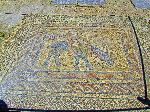 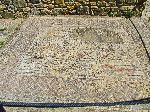 The
House of the Athlete's
most interesting mosaic (left) is that of a poorly rendered athlete or acrobat riding
a less than athletic looking horse or mule backwards and
holding a large cup or trophy. It is hard to know if its intent is to be serious
or humorous. A second prominent mosaic is that of sea creatures (right). The
House of the Athlete's
most interesting mosaic (left) is that of a poorly rendered athlete or acrobat riding
a less than athletic looking horse or mule backwards and
holding a large cup or trophy. It is hard to know if its intent is to be serious
or humorous. A second prominent mosaic is that of sea creatures (right). |
|
| |
|
|
|
| |
House of the Dog |
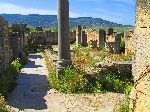 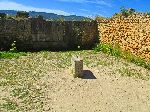 The
house is named for a statue of a dog that in now at a museum. Now the most
identifiable item in the building is a monument with a phallus
on top. In Roman tradition, this typical mark the brothel in a
roman town. It is hard to know if the monument has been in place since
antiquity, or if it was moved at some point. In any case, its presence in Volubilis
and the presence of a brothel in town should come as no surprise. The
house is named for a statue of a dog that in now at a museum. Now the most
identifiable item in the building is a monument with a phallus
on top. In Roman tradition, this typical mark the brothel in a
roman town. It is hard to know if the monument has been in place since
antiquity, or if it was moved at some point. In any case, its presence in Volubilis
and the presence of a brothel in town should come as no surprise. |
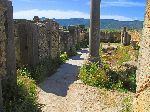 |
| |
|
|
|
| |
House of Ephebe |
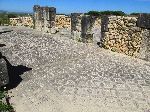
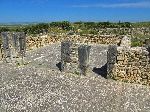
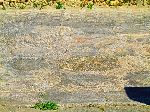
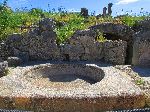 |
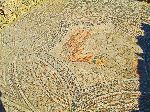 |
| |
|
The House of
the Ephebe (or Euphebus) was named after a bronze statue found there. It has a prominent
interior courtyard leading to a number of public rooms decorated with large mosaics.
Most of the mosaics are of patterns and shapes, but one
includes a depiction of Bacchus in a chariot being drawn by leopards. |
|
| |
|
|
|
| |
House of Columns |
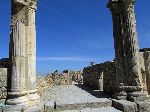
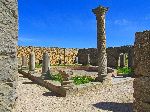
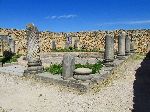
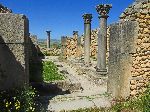 |
|
| |
|
The aptly named House of Columns, has a multitude of columns, many with
unique details, including a couple
with a spiral pattern covering the columns. There was an olive oil press in the
house. |
|
| |
|
|
|
| |
House of the Knight / Horseman / Cavalier |
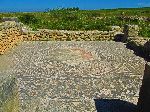 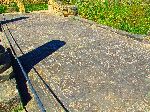 The
name of the house varies depending upon who is doing the translation. Its most
significant mosaic is that of Bacchus encountering the sleeping Ariadne (left).
She later was the mother of six of his children. The house takes it name from a
bronze statue that was found there. The
name of the house varies depending upon who is doing the translation. Its most
significant mosaic is that of Bacchus encountering the sleeping Ariadne (left).
She later was the mother of six of his children. The house takes it name from a
bronze statue that was found there. |
|
| |
|
|
|
| |
House of the Labors of Hercules |
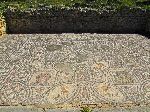 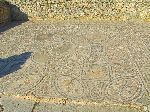 The
focus of the House of the Labors of Hercules is the eponymously named mosaic. It depicting the
twelve tasks that the demigod had to perform as penance for killing his wife and
children. The
focus of the House of the Labors of Hercules is the eponymously named mosaic. It depicting the
twelve tasks that the demigod had to perform as penance for killing his wife and
children. |
|
| |
|
|
|
| |
House of Dionysus, or House of Four Seasons. |
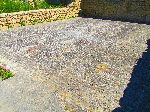 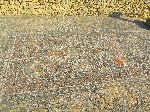 The
Four Seasons are a common theme for Roman mosaics in North Africa. The mosaic of
four seasons in sometimes located as among the 41 rooms of the House of the
Labors of Hercules and sometimes being at a separate eponymous named house
next door. The
Four Seasons are a common theme for Roman mosaics in North Africa. The mosaic of
four seasons in sometimes located as among the 41 rooms of the House of the
Labors of Hercules and sometimes being at a separate eponymous named house
next door. |
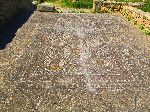 |
| |
|
|
|
| |
House of Wild Beasts |
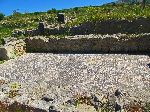 The
mosaic is badly deteriorated but it illustrated the range of themes that were
incorporated into the art form. The
mosaic is badly deteriorated but it illustrated the range of themes that were
incorporated into the art form. |
|
| |
|
|
|
| |
House of Nereids |
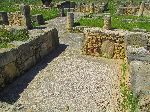
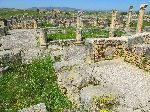
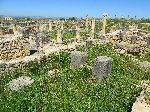 |
|
| |
|
|
|
|
House of Venus |
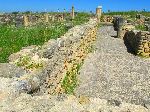
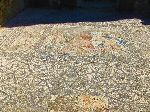
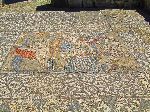
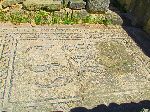 |
|
| |
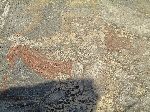 |
The House of Venus is one of
the largest and most elegant in Volubilis. This would explain why it was, for a time, the home of King Juba II (b.
52 BC, r. 29 BC, d. 23 AD), the Berber king of Roman Mauretania and Numidia.
King Juba II is remembered for supporting scientific research and the performing
arts and fostering the development of the olive oil production, vineyards, and
coastal fisheries in the region, all of which remain viable. The mosaic of
Venus has been moved to a museum, but there are still in situ of Diana and the
horned,
hunter
Actaeon,
Diana and her nymph
surprised while leaving the bath by Actaeon, and of dolphins, a good luck symbol
in the culture. |
|
| |
|
|
|
| |
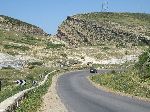 |
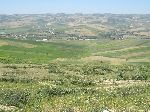 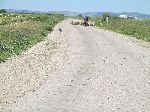 West
of Volubilis, the road from Meknes to Sidi Kacem takes advantage of a cut through the ridge
that was created by Oued Saiss,
a tributary of Oued Baht. West
of Volubilis, the road from Meknes to Sidi Kacem takes advantage of a cut through the ridge
that was created by Oued Saiss,
a tributary of Oued Baht.Southeast of the cut it is completely different with
rolling hills to the horizon. The river has somehow found a twisting route of
least resistance at the bottom of the winding Saiss Valley, zigzagging endlessly around hills. The dominate land use
changes for field crops to a greater amount of grazing. Northwest of the cut the
landscape is flat to the horizon. |
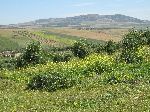 |
| |
|
|
|
| |
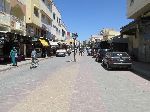 |
Ten kilometers east of
Sidi Slimane is the similar sized town of Sidi Kacem (left).
During the French period, it was called Petitjean, after a French captain who
was killed in May 1911 during the "pacification" of Morocco. The French drilled
some oil wells is the area, but there is no evidence that it was ever a major economic engine
for the region. That would be occupied by agriculture.
Ten kilometers west of Sidi
Kacem is the similar sized town of Sidi Slimane (right).
It is the administrative headquarters for Sidi Slimane Province. It
is mostly renowned for its quality citrus products. |
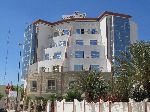 |
| |
|
|
|
| |
|
Moulay
Idress

 Rabat Rabat |
|
| |
|
|
|
| |
|
 |
|
| |
|
|
|
 |
|
|
 |